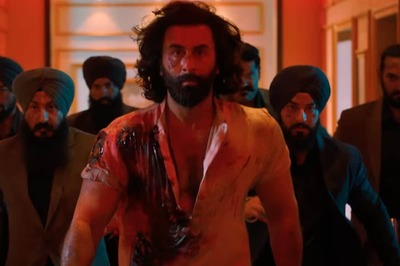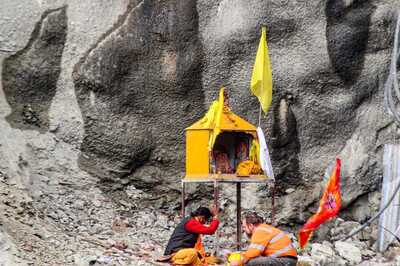
views
It is ironic that China should now be playing second-fiddle to India in both the Shanghai Cooperation Organisation (SCO) and BRICS. This is not admitted to by either side, but perceptually it is increasingly evident. India held the rotating chair in the SCO for a year most successfully till it ended recently, and appears to be dominating the agenda at the BRICS Summit in Johannesburg too. So much so, that while India’s Prime Minister Narendra Modi pointed out that it will soon be a $5 trillion economy open to do business with the Global South and others, Chinese President Xi Jinping did not make a speech, and stayed away from the business session attended by the other three.
Russia’s President Vladimir Putin joined in virtually from Moscow. This is the first in-person summit of BRICS since 2019. Prime Minister Modi called India the growth engine of the world in an unabashed pitch to over 40 countries present, and the global audience via coverage of the ongoing three-day event.
Russia was represented by its highly experienced Foreign Minister Sergey Lavrov. It complained, as expected, about the Western sanctions imposed on it, but pledged support to the Global South, and Africa in particular. If President Putin was referring to grain shipments, Africa would note that those too were disrupted more than once.
India is more credible in this matter, because of its timely help with vaccines during the Covid pandemic, while most others, including the rich Western countries, hoarded their own supplies. Its treatment of the many additional invitees to the G20 Summit approaching its climax next month is also much appreciated by the Global South and indeed most of the G7 countries as well, including Japan and France.
Xi did attend the retreat for the heads of government, but, reading between the lines, did not make any headway with China’s bid to expand the BRICS line-up immediately. China wants to form a larger block to rival the domination of the ‘Global Commons’ regime, helmed by the US. However, previous attempts ranging from the post-colonial Non-Aligned movement to the G-15 have never been effective. A line-up of about 45 countries in BRICS is unlikely to do any better.
This ‘Commons’ regime refers to the dominance of the US dollar as a global reserve currency, the SWIFT system as the international method of banking money flows, and free and open access to the trade waterways of the high seas. It also includes America’s established hold on a number of global institutions, and defence cooperation-oriented organisations such as NATO, AUKUS and QUAD.
Any attempt to go beyond talking about a BRICS currency is unrealistic. India has made headway in trading bilaterally in local currencies with a number of countries, but this too is hampered with not enough presence in global trade. As India’s economy grows, the rupee will gain greater acceptance in international trade, said Columbia University professor and economist Arvind Panagariya in a recent article.
China, by way of contrast, could not properly float its external Yuan as an exchange currency and has been struggling to make something of the Regional Comprehensive Economic Partnership (RCEP), an Asia-Pacific-based trade pact, akin to a common market. Many in it are chafing at the direction from China which tends to advantage it, and India, of course, has refused to join just as it refused to join China’s Belt and Road initiative. This was prescient because it has severely stressed or bankrupted those who have.
India, under Modi, since 2014, has been joining and participating in other regional meetings of organisations such as the Association of Southeast Asian Nations (ASEAN). These are influential, but not subject to outright Chinese domination. It is also making every effort in BIMSTEC, particularly with Bangladesh and Sri Lanka, the successor, more or less to SAARC, that has been stymied by Pakistan. Relations with Nepal too are getting better with its infatuation with Chinese communism on the decline.
India is trying hard to reduce its trade with, and investment from, China. Moves like the licencing of the manufacture of laptops and other electronic items is a step in this direction.
Given the eyeball-to-eyeball confrontation of over 50,000 troops with massive deployment of military equipment on each side along the Line of Actual Control (LaC), the relationship between India and China is not good.
Intrusions and illegal holding of perceived Indian territory in Eastern Ladakh, actual skirmishes and clashes in Ladakh and in Arunachal Pradesh make up an adverse list, alongside Chinese training, arming and funding of multiple insurgencies in India. Chinese encouragement of Pakistani terrorism is also a huge problem, as is its blocking of Indian initiatives against terrorists in the UN. China has also blocked Indian membership in the Nuclear Suppliers Group.
Chinese companies that have been operating in India have been caught evading taxes and breaking rules. Most Chinese companies are now banned from making investments in India. China itself has also broken international trading rules after joining the World Trade Organisation (WTO).
Indian diplomacy has been candid in stating that the relationship with China is, at present, not normal and cannot be, given the circumstances. Even today, China is regularly menacing the Philippines, Vietnam, Taiwan and Japan in its near neighbourhood. Against this backdrop, the possibility of a bilateral meeting at Johannesburg between Prime Minister Narendra Modi and President Xi Jinping is unlikely and rather pointless.
However, both are conducting many bilateral meetings with the other BRICS members and over 40 invited countries, many of whom want to join BRICS.
PM Modi in Johannesburg also called for the building of a ‘resilient supply chain’, a diplomatic code used by the Americans to reduce dependence on China. China, on its part, complained rather bitterly of US ‘hegemony’ and hostility towards the poorer countries of the Global South. While this may seem incongruous in a BRICS Summit, perhaps it is trying to claw back some vestiges of its global image that has taken a severe battering of late.
Not only is China regarded as the villain of the piece with regard to the global Covid pandemic that has taken millions of lives, but its plummeting economy, huge unemployment, collapsing companies, and chronic belligerence has put off most of the world. African countries have been expelling the Chinese for their arrogant, racist, and predatory ways. Most of the world is losing faith in China’s ambitions given its sharp decline.
The only economy that is growing strongly amongst the five present members of BRICS is India’s. And India has apparently persuaded the other two present — namely Brazil’s Lula da Silva and South Africa’s Cyril Ramaphosa — to agree to a process for expanding the BRICS line-up first.
The Shanghai-based BRICS Bank, formally known as the New Development Bank, has failed to rival the major US-backed multilateral lending institutions such as the World Bank, the International Monetary Fund (IMF), the Asian Development Bank (ADB) and others.
India is a darling to these institutions, with its approximately 7 per cent GDP growth year on year. It is called a ‘beacon of hope’ in a world troubled economically, at present.
US President Joe Biden has stated that he considers India to be the most important country to him, in the backdrop of the BRICS Summit, and will be visiting New Delhi shortly between 7-9 September for the G20 Summit, along with a host of other heads of government. His announced agenda at the G20 is to condemn Russia for the Ukraine War.
This 15th Summit of BRICS was preceded by Prime Minister Modi pointing out the need to identify new areas of cooperation. He will go to Greece on August 25 from South Africa for a day-long visit, on his return path to India. Greece is offering a gateway to Europe for India, even as it has been interacting closely with rival China in recent years after its economy went bankrupt and was rescued by its membership of the EU and massive new loans.
Like the rivalry in BRICS and SCO, India and China will continue to compete with each other in the global arena, and in economy-oriented organisations. This will have multiple effects on the geopolitics of the world, but India’s economy, much smaller than China at present, is assured of medium to long-term success. This is mainly because of an alignment with America and its Western allies that give it an edge in security matters. India’s largely atmanirbhar (self-reliant) economy, backed by strong domestic demand and proportionate exports, is poised to make it the third biggest in the world by 2028-2030. After that, its numbers won’t stay very much smaller than those of the Chinese economy, presently at number 2.
The writer is a Delhi-based political commentator. Views expressed in the above piece are personal and solely that of the author. They do not necessarily reflect News18’s views.




















Comments
0 comment